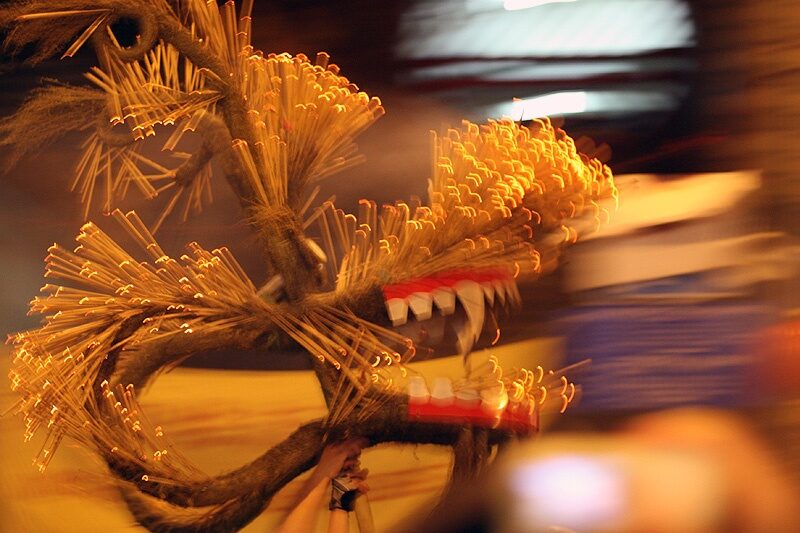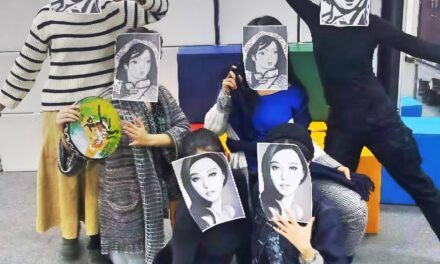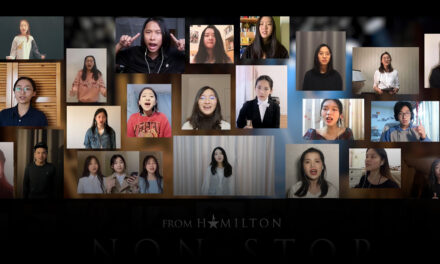The rhythmic sound of drumming echoes through the streets. Tai Hang is normally quiet on weeknights, but tonight it is filled with people. In an alley near the Chinese Recreation Club, on the edge of the neighborhood, a creature waits in the dark. With a body of rope and a head crafted from rattan and metal, it’s a dragon, and it lies sleeping on the ground – for now.
Soon, a man steps forward with three lit joss-sticks. Other men get into position around the beast. After bowing three times in each direction and saying an incantation over the dragon’s head, the man places the smoldering incense sticks into the dragon’s head. The drumbeats grow frenzied as the dragon’s head flies into the air, hoisted up by the strongest man on the team. The body rises. The dragon surveys the scene and shoots off above the crowd, winding its way through the streets of Tai Hang, towards the Lin Fa Kung Temple. The crowd chases after it, trying to keep up.
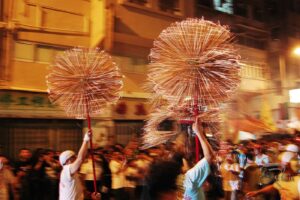
This is the fire dragon, which appears every year during the Mid-Autumn Festival (Zung1 Cau1 Zit3 中秋節), a very important time for the Chinese diaspora. At its heart, it is a harvest festival around the time of the autumnal equinox. Celebrated on the 15th day of the eighth lunar month, the festival centres on the full moon. The festival’s origins can be traced back to the Shang Dynasty (1600-1046 BC). The simple act of thanking the gods for a bountiful harvest is an ancient and universal concept, and that is exactly what the original form of Mid-Autumn Festival entailed. During the Tang Dynasty (618-907 AD), the festival became more popular and moon gazing started to become an important feature of the celebrations. At first, the emphasis was on gathering the family together and admiring the moon, as it was a mysterious and profound cosmic phenomenon. Ancient Chinese people believed that the moon was a source of life for plants, so the association of the harvest festival and the moon was obvious.
Traditionally, only women worshipped the moon, as their monthly cycles were linked to its phases. As the festival continued to develop, a universal form of moon worship began to merge into the rituals. One particular moon deity, the ancient goddess Chang’e (Soeng4 Ngo4 嫦娥), has become the most important over the centuries. The goddess has been in the Chinese pantheon since at least the Xia Dynasty (2070-1600 BC), but the myth of the goddess’ creation that was passed from generation to generation developed with each telling. There are a few variations, but the standard one is known by most Chinese people and has become associated with the Mid-Autumn Festival, as it is told to children by their parents and grandparents as they sit under the moon.
Once there were ten suns in the sky, represented by three-legged crows. These sun birds were the children of the god Di Jun (Dai3 Zeon3 帝俊) and were meant to take turns to circle the earth each day. The suns became disobedient and started to fly around the world all at once. The land was scorched and could not sustain crops. Di Jun sent for the famous archer Houyi (Hau6 Ngai6 后羿) to solve the problem. Houyi shot down nine of them, leaving just one sun. As a reward, he was granted the elixir of immortality, but refused to take it, as he would have to ascend to heaven and leave his beloved wife Chang’e. Houyi left the elixir in her care, but one day, Chang’e was forced to drink it to stop it falling into the hands of a robber. As she ascended to heaven, she chose the moon as her abode in order to be as close as possible to her husband on Earth. Her devastated husband would then put Chang’e’s favorite fruits and cakes out under the moonlight as sacrificial offerings to her each day.
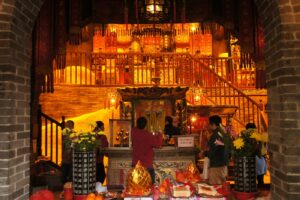
Houyi’s act of devotion is emulated by the laying out of fruit such as peaches, pomegranates, and pomelos on a makeshift altar in the courtyard of a home. In modern Hong Kong, a balcony serves the purpose. The offering and eating of mooncakes is the most well-known tradition. Legend ascribes their origins to the Emperor Taizong of Tang being given them as a memorial to a victory over the western Xiongnu nomadic people on the 15th day of the eighth lunar month. As this was the Mid-Autumn Festival, he dedicated them to the moon. Historically, they were more likely popularized during the later Song Dynasty (960-1279). The osmanthus flower is also associated with the festival, as it was believed to grow on the moon. The legend says that it is perpetually harvested by Wu Gang (Ng4 Gong1 吳剛), a mysterious figure from Taoist folklore, as a punishment for his misdeeds. Osmanthus is used in candies and Cassia Wine (gwai3 faa1 zau2 桂花酒) that are consumed during the Mid-Autumn celebrations.
Lanterns, an iconic part of the Mid-Autumn celebrations, are also a Tang Dynasty addition to the festival. Their precise connection is unclear, but they symbolize fertility and are intrinsically linked to the festival, embodying it as strongly as mooncakes. During the Qing Dynasty (1644-1912), fishermen in Hong Kong put lanterns on their boats during Ghost Month to help guide spirits of drowned people. They would keep the lanterns on their boats until the beginning of the Mid-Autumn Festival. Water is still important in Hong Kong and many families and friends gather on the public beaches with fish and pomegranate shaped lanterns to spend time together and watch the full moon rise.
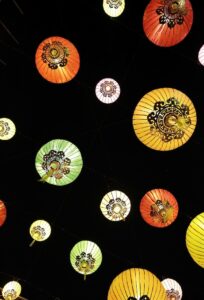
The most iconic of the Mid-Autumn events in Hong Kong is the Tai Hang Fire Dragon Dance. Tai Hang is now a neighborhood that adjoins Causeway Bay, but it was once a Hakka fishing village. Even today, looking at it on a map, you can clearly see the tight grid of old village streets and the curve of Tung Lo Wan Road, which ran along the shoreline until land reclamation in the 1950s. Until the 1990s it was a poor neighbourhood with shanties that sprawled up the surrounding hillsides. The grandest building was Lin Fa Kung, the temple to the Goddess of Mercy, Kwun Yum (Gun1 Yam1 觀音), built in 1863. These days, Tai Hang is a quickly gentrifying destination for eating and drinking.
In 1880, a typhoon hit Hong Kong and caused severe damage just before the Mid-Autumn Festival. During the storm, a python entered Tai Hang, causing problems for the villagers. The residents caught and killed the snake. The next day, its body disappeared and people in Tai Hang began to fall ill from a mysterious plague. A village elder had a dream in which the Buddha told him that the python was the son of the Dragon King (Lung4 Wong4 龍王). The elder was instructed to organise a three-day fire dragon dance to atone for the killing and abate the anger of the Dragon King. The villagers constructed the dragon and performed the three-day dance. The sulphur in the incense drove away the disease and the Dragon King was appeased by the display that honoured him.
The dance has been performed every year since then, with two exceptions: the Japanese Occupation from 1941 to 1945 and the 1967 Leftist Riots. The Hakka village of Pok Fu Lam also claims to be part of the story and its villagers say that the snake actually appeared there rather than in Tai Hang. Whatever the truth may be, Pok Fu Lam has emulated Tai Hang’s dragon dance for several decades, with the quirk that several small dragons accompany the main fire dragon back to its home in the sea.
As the dragon is prepared for its healing journey through Tai Hang, onlookers pack into cordoned-off streets. There is hardly room to move a muscle. The anticipation is tangible. Everyone is waiting for the coming beast. Police officers watch over the crowd, keeping everyone at bay behind police tape and rope cordons. The main street of the village, Wun Sha Street, is almost impossible to reach, so most people await the dragon along other parts of its traditional route.
The dragon emerges from Lin Fa Kung on Lily Street, a blazing mass of joss sticks. It follows two spinning pearls of wisdom — orbs of incense — that lead the way. As it traces its way through the rows of buildings, smoke pours out into the crowd. The fiery creature flies past, pushing evil forces away, clearing the neighbourhood of its plague-causing spirits. The crowd strains to glimpse the fast-moving dragon. The dragon finally makes its last run down School Street, past the hoards at the end of Wun Sha Street and back to its lair in the temple of Kwun Yum. The smoke dissipates, signalling that it is time for the crowds to do the same.
In 2021, the Mid-Autumn Festival falls on September 21. This year’s fire dragon dances should have been held over three days, from September 20 to 22. It was cancelled on September 14th. We apologize for this late information.
Note: Cantonese romanization in this article is based on the jyutping system, which uses numbers to correspond to the six main tones in Cantonese.
This article was originally published by Tom Billinge on zolimacitymag.com on September 19, 2021, and has been reposted with permission. To see the original article, click here.
This post was written by the author in their personal capacity.The opinions expressed in this article are the author’s own and do not reflect the view of The Theatre Times, their staff or collaborators.
This post was written by Zolima CityMag.
The views expressed here belong to the author and do not necessarily reflect our views and opinions.

